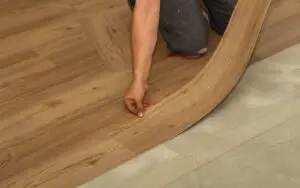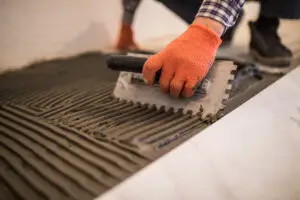Understanding Hardwood Floor Refinishing
What Does Refinishing Entail?
The Basics of Refinishing
Refinishing hardwood floors is a process that rejuvenates the wood by removing the old, worn finish and applying a new one. This typically involves sanding down the top layer of the wood, which eliminates scratches, dents, and other surface imperfections. After sanding, a new stain or finish is applied, restoring the floor’s original beauty or providing a fresh new look. The process requires a keen eye for detail and specialized equipment, ensuring that the floor is evenly sanded and finished to achieve a flawless result. Refinishing is not just about aesthetics; it also helps protect the wood from future damage, extending its life and maintaining its value.
Why Refinish Hardwood Floors?
Refinishing hardwood floors is essential for several reasons. Over time, everyday wear and tear, spills, and foot traffic can dull the finish and create visible scratches and dents. These imperfections not only detract from the beauty of the floor but also compromise its protective layer, making it more susceptible to damage and staining. Refinishing restores the original luster and provides a renewed protective coat, which extends the floor’s life and improves its appearance. Moreover, refinishing allows homeowners to change the stain color, providing an opportunity to update the look of the room without the cost of full replacement. Proper maintenance, including timely refinishing, can save you money in the long run by preventing the need for costly repairs or replacements.
Common Hardwood Floor Issues
Scratches and Dents
Scratches and dents are common issues in hardwood floors, particularly in high-traffic areas or homes with pets and children. These marks can accumulate over time, detracting from the floor’s appearance and giving it a worn-out look. While some minor scratches might be manageable with touch-up products, deeper scratches and dents often require sanding and refinishing to fully remove. Ignoring these issues can lead to further wear, making the floor more susceptible to damage, and ultimately, necessitating more extensive repairs.
Dullness and Wear
Over time, the protective finish on hardwood floors can wear thin, causing the wood to lose its luster and shine. This dullness is often most noticeable in high-traffic areas, where constant foot traffic wears down the finish. This lack of sheen can make the floor look old and tired, and it also makes the wood more vulnerable to moisture and staining. Refinishing the floors will restore the protective layer and bring back the rich, vibrant look, which will make your floor look its best.
Water Damage and Stains
Water damage and stains are significant threats to hardwood floors. Spills, leaks, and high humidity levels can cause warping, discoloration, and even rotting of the wood. Water damage often leads to staining that penetrates the finish, making it difficult to remove. If left untreated, water damage can severely compromise the integrity of the wood, requiring extensive and costly repairs or even floor replacement. Refinishing, when done promptly, can mitigate some water damage, remove the staining, and protect your floors from future issues.
DIY Refinishing: The Process and Challenges
DIY Refinishing Steps
Step 1: Sanding
Sanding is the most crucial and challenging part of DIY wood floor refinishing. It involves using a floor sander to remove the old finish and any surface imperfections. The process requires careful technique and attention to detail; if the sanding is uneven, it will be extremely noticeable after the refinishing. Uneven sanding often leads to swirl marks, gouges, and an overall unprofessional look. It’s critical to use the correct grit of sandpaper and to make multiple passes, each time with a higher grit, to smooth the wood. Renting the proper equipment can be expensive, and the learning curve for using it correctly can be quite steep for a DIYer.
Step 2: Staining
Once the floor is sanded, you might opt to apply a new stain to change its color. This step is critical for ensuring the stain is applied evenly and smoothly. Inconsistencies can result in blotches and uneven color distribution, which can diminish the overall aesthetic of the floor. Applying stain too thickly or too thinly, or failing to properly prepare the surface, can lead to an unprofessional finish. Choosing the right stain and ensuring it complements your decor is also key; an incorrect stain can also result in a look you don’t enjoy.
Step 3: Finishing
The final step in the DIY refinishing process is applying a finish to protect the wood and provide a sheen. The finish is essential for protecting the wood from everyday wear and moisture. Uneven application, failure to use the correct type of finish, or applying it to a dirty surface can result in streaks, bubbles, or a poor protective layer. Multiple coats are often needed, and the curing time must be strictly adhered to. Errors made in this final step can undo all previous work, causing a lot of frustration and wasted time.
Required Tools and Materials
Sanding Equipment
Sanding equipment includes a drum sander, an edger, and various grades of sandpaper. These tools are essential for removing the old finish and smoothing the floor. Renting these tools can be costly, and if you don’t have experience with them, you may find yourself dealing with uneven sanding or damage to the floor. The drum sander, in particular, requires careful handling and practice to avoid gouging the wood. The edger, which is used along the edges and in corners, requires precision to ensure a consistent finish.
Finishing Supplies
Finishing supplies include stains, sealers, and topcoats, and these are necessary to protect the wood and enhance its appearance. Selecting the appropriate products is vital, as different types of finish have different characteristics, such as durability, gloss level, and drying times. Applying the finish correctly also requires the right tools, like applicators and brushes, as well as a clean environment to avoid dust or debris getting trapped in the finish. Using low-quality or incorrect products can lead to poor results and may not adequately protect your wood flooring.
Safety Gear
Safety gear is critical for a DIY refinishing project. This includes items like respirators, safety glasses, gloves, and ear protection. Sanding generates a lot of dust, which can be harmful if inhaled, and some finishes release toxic fumes. Wearing appropriate safety gear is not only recommended but essential for protecting your health. It’s very important to avoid shortcuts; failing to use the right safety gear can lead to health issues and discomfort.
Common DIY Pitfalls
Uneven Sanding
Uneven sanding is a very common and very visible pitfall in DIY floor refinishing. It is caused by inexperienced users applying inconsistent pressure or using the sander improperly, which results in an uneven and unattractive surface. These imperfections may be difficult or even impossible to fix without redoing the entire floor, which will waste both time and money. Addressing this issue often requires professional help, which adds to the total cost of the project.
Improper Finishing
Improper finishing can lead to a variety of problems. These can include streaking, bubbling, or an uneven sheen. It’s often the result of applying the finish too thickly or too thinly, using the wrong type of applicator, or not preparing the surface properly. These flaws not only detract from the appearance of the floor but may also compromise the finish’s protective properties. Addressing this issue may necessitate sanding down the newly finished floor and redoing the finish all over again, which is incredibly time-consuming and frustrating.
Dust and Mess
Refinishing floors generates a lot of dust, which is hard to contain and even harder to clean. This dust can spread throughout the house, settling on furniture, in ventilation systems, and in other spaces. Without professional containment methods, homeowners will spend a lot of time dealing with the dust issues, even after the sanding and refinishing are complete. Proper dust control measures, such as sealing off rooms and using industrial-grade vacuums, are difficult for DIYers to implement, which makes it a messy and inconvenient project.
The Professional Refinishing Advantage
Benefits of Hiring Professionals
Expertise and Experience
Professional floor refinishers bring years of experience and specialized knowledge to the table. They understand the unique challenges of different types of wood and finishes, and they have the skills to achieve a flawless result. Their expertise allows them to identify and address issues early on, preventing costly mistakes. This experience ensures that your floor refinishing project is done right the first time, saving you both time and money.
Professional-Grade Equipment
Professionals use high-quality, professional-grade equipment that is much more effective than the tools available for rent. This equipment allows for more precise sanding, more even finish application, and better dust control. These tools are costly and require specialized training to operate correctly, making them impractical for DIY projects. Professionals also have the expertise to use these tools safely and efficiently.
Time and Efficiency
Refinishing floors is time-consuming work that requires skill and attention to detail. Professionals are trained to work efficiently without sacrificing the quality of their work, saving you valuable time. They can complete the project in significantly less time than a DIYer, while also ensuring the job is done correctly. This efficiency allows you to resume your routine much sooner, without the prolonged inconvenience of a DIY project.
How Professionals Approach Refinishing
Detailed Assessment
A professional refinisher will start with a comprehensive assessment of your floors. This allows them to identify any issues like hidden damage, weak spots, or the type of wood in use. This detailed assessment allows them to create a plan that is perfectly suited to your needs, ensuring that the right tools, methods, and finishes are used for the best results. This assessment minimizes the chances of any unpleasant surprises during the process.
Specialized Techniques
Professionals use specialized techniques that are very hard for DIYers to learn or execute. This might include advanced sanding techniques, precise stain application, and dust control measures that are critical for getting the best result. These techniques ensure that your floors will get a superior finish, enhancing its appearance and protecting the wood. Professionals know how to execute each step flawlessly, providing long-lasting, durable results.
Quality Control
Professional floor refinishers follow a strict quality control process, which includes regular checks throughout the process. This helps to ensure that the job meets the highest standards of quality. Their goal is to provide you with a flawless finish that will look great and last for years to come. They will always stand behind their work, and often provide warranties, ensuring your satisfaction.
Cost Comparison: DIY vs. Professional
DIY Cost Factors
Equipment Rental
Renting sanding equipment is a significant expense for DIY projects. Rental costs can be surprisingly high, and the quality of rented equipment may not always be the best, which can affect the final results. These machines often require experience to operate properly, and the rental price can escalate quickly with each day that you need them. Remember, you may need to rent multiple pieces of equipment, adding to the expense.
Material Costs
Material costs for DIY projects include sandpaper, stain, sealers, and finishes. The cost of these materials can add up quickly, especially if you need multiple coats or make mistakes that require additional products to fix. Choosing the right types of products is critical, and mistakes in this area can lead to expensive do-overs. Lower-quality products might be cheaper initially, but could require more frequent reapplications, which will cost more over time.
Potential Repair Costs
DIY refinishing projects are prone to mistakes, which can lead to additional repair costs. These costs can include fixing uneven sanding, repairing damage to the floorboards, or correcting application errors. These additional repair costs can quickly outweigh any initial savings from doing the project yourself. In some cases, it might be necessary to hire a professional to correct DIY mistakes, which increases the overall expense of the project.
Professional Cost Factors
Detailed Estimates
Professional refinishers provide detailed cost estimates before starting any work, which allows you to have a clear understanding of the costs involved. These estimates typically include all the materials, labor, and any necessary prep work. This transparency helps to avoid unexpected costs and allows you to budget effectively for your refinishing project.
Value for Money
While professional services may seem more expensive initially, they often provide better value for money. Professionals deliver a high-quality result that will last longer, reducing the need for frequent refinishing or costly repairs. The expertise and quality of the finished product often outweighs the additional upfront cost. Furthermore, they also guarantee the quality of their work, giving you extra peace of mind.
Warranty and Guarantees
Professional refinishing services often come with warranties and guarantees that protect you against any defects or issues in the work. If something goes wrong, the professional will often return to correct it, saving you both time and money. These guarantees also offer peace of mind, knowing that your investment is protected. A warranty ensures that you are covered if the product fails prematurely, and most professional companies stand behind their products and craftsmanship.
DIY vs Professional Services: Examples and Case Studies
DIY Disaster Case Studies
Example 1: Uneven Sanding and Finish
A homeowner decided to refinish their own hardwood floors, and rented a drum sander to prepare the surface. They ended up with an uneven sanding surface because they had no experience using the machine, and they made some common mistakes. This caused the stain to look splotchy and the finish to look uneven and unprofessional. They had to sand the entire floor down again to redo the process, adding significant time and cost to the project. This case clearly shows how easily DIY projects can fail without the correct training and expertise.
Example 2: Damage to Floorboards
Another homeowner, in an attempt to save some money, tried to refinish their floors without any professional assistance. During sanding, they were too aggressive, using the wrong grit of sandpaper and applying too much pressure. They ended up damaging the floorboards and had to replace several of them before even finishing the job. This case highlights the importance of using the proper technique and tools when refinishing wood floors, and the potential risks when that is not the case.
Professional Refinishing Success Stories
Example 1: Restoring Historic Floors
An owner of a historic home hired a professional company to refinish the original wood floors. The floors were damaged by years of use, and some previous attempts to repair them. The professionals assessed the situation, and developed a comprehensive plan, and carefully restored the wood, bringing the original beauty and charm back to the floor. They also managed to protect the floors from future damage, extending their lifespan for many years to come.
Example 2: Addressing Severe Water Damage
Another homeowner had a leak that caused water damage to their hardwood floors, resulting in discoloration and warping. The professional refinishers were able to properly dry the area and address the water damage before refinishing the floors. The final result was a perfectly repaired floor that looked as if nothing had happened, saving the homeowner from having to replace the entire floor. The professionals also helped them prevent future water damage by properly sealing the area.
FAQs & Answers
While it might seem convenient to use a hand sander for a small area or a quick fix, using a hand sander instead of a floor sander for an entire room is not recommended. Floor sanders are specifically designed to sand large areas evenly, while hand sanders are smaller and more difficult to control, making them inefficient for larger areas. Using a hand sander for an entire floor can also lead to uneven surfaces and a poor result. Professionals use specialized floor sanders, and with them, achieve a consistently even surface that’s crucial for a professional finish. This is why hiring a professional is usually the best option.
The time it takes to refinish hardwood floors depends on many factors, including the size of the room, the condition of the floors, and the type of finish used. A DIY project can often take several days, and even weeks if you factor in the learning curve and all the mistakes made. Professional refinishers, on the other hand, often complete a project in a few days thanks to their specialized equipment and proven techniques. This efficiency minimizes disruption and allows you to enjoy your newly refinished floors much sooner. Therefore, hiring a professional is a far more efficient and effective way to ensure your floors are properly refinished.
The best type of finish for your floors depends on a variety of factors, including your lifestyle, your personal preferences, and the type of wood used in your floors. Oil-based finishes are known for their durability, while water-based finishes are more environmentally friendly. Professionals will be able to properly assess your needs and recommend the right finish for your specific floors. They can ensure that the finish is applied properly for optimal protection, resulting in a beautiful and long-lasting surface. Choosing the wrong type of finish can cause all sorts of issues, which is why it's best to always consult an expert.
The frequency of refinishing depends on the traffic and wear your floors experience. In high-traffic areas, you might need to refinish every 7-10 years, while low-traffic areas may only need it every 10-15 years. Professional assessments can help you determine the best time to refinish your floors. They’ll inspect for signs of wear and tear, and recommend the best approach for your situation, ensuring you are not refinishing your floors too often, or too little. Timely refinishing, done by experts, helps to maintain your floor's appearance and extend its life, saving you money over time.
Refinishing is almost always more cost-effective than replacing your floors, provided the damage is not too extensive, and the underlying wood structure is in good condition. Refinishing can save you a lot of money, while completely transforming the look of your home. Hiring professionals will ensure that the job is done right, protecting your investment and increasing the value of your home. With professional refinishing, your hardwood floors will look new, and they will last for many more years to come. Therefore, unless your floors are severely damaged, refinishing is the best option.





